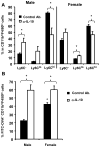Increased T regulatory cells lead to development of Th2 immune response in male SJL mice
- PMID: 20883149
- PMCID: PMC3733367
- DOI: 10.3109/08916934.2010.519746
Increased T regulatory cells lead to development of Th2 immune response in male SJL mice
Abstract
SJL mice represent a mouse model in which young adult females are susceptible to autoimmune disease, while age-matched males are relatively resistant. T cells primed in female SJL mice secrete cytokines associated with a Th1 phenotype. By contrast, T cells primed in males secrete cytokines associated with a Th2 phenotype. Activation of Th2-type T cells in males vs. Th1 cells in females correlates with increased CD4(+)CD25(+) T regulatory cells (Treg) in males. T cells primed in males depleted of CD4(+)CD25(+) T cells preferentially secrete IFN-γ and decreased IL-4 and IL-10 compared to CD4(+)CD25(+) T-cell-sufficient males, suggesting that Treg influence subsequent antigen-specific cytokine secretion. Treg from males and females exhibit equivalent in vitro T-cell suppression. Treg from males express increased CTLA-4 and CD62L and preferentially secrete IL-10. These data suggest that an increased frequency of IL-10 secreting Treg in male SJL mice may contribute resistance to autoimmune disease by favoring the development of Th2 immune responses.
Figures







Similar articles
-
Induction of antigen specific CD4(+)CD25(+)Foxp3(+)T regulatory cells from naïve natural thymic derived T regulatory cells.Int Immunopharmacol. 2015 Oct;28(2):875-86. doi: 10.1016/j.intimp.2015.03.049. Epub 2015 Apr 13. Int Immunopharmacol. 2015. PMID: 25882104
-
CD4+CD25+Foxp3+ T regulatory cells, Th1 (CCR5, IL-2, IFN-γ) and Th2 (CCR4, IL-4, Il-13) type chemokine receptors and intracellular cytokines in children with common variable immunodeficiency.Int J Immunopathol Pharmacol. 2016 Jun;29(2):241-51. doi: 10.1177/0394632015617064. Epub 2015 Dec 18. Int J Immunopathol Pharmacol. 2016. PMID: 26684629 Free PMC article.
-
CD4+CD25+Foxp3+ regulatory T cells depletion may attenuate the development of silica-induced lung fibrosis in mice.PLoS One. 2010 Nov 3;5(11):e15404. doi: 10.1371/journal.pone.0015404. PLoS One. 2010. PMID: 21072213 Free PMC article.
-
Alloantigen specific T regulatory cells in transplant tolerance.Int Immunopharmacol. 2009 May;9(5):570-4. doi: 10.1016/j.intimp.2009.01.016. Epub 2009 Jan 29. Int Immunopharmacol. 2009. PMID: 19539571 Review.
-
IL-10 as a Th2 Cytokine: Differences Between Mice and Humans.J Immunol. 2021 Nov 1;207(9):2205-2215. doi: 10.4049/jimmunol.2100565. J Immunol. 2021. PMID: 34663593 Free PMC article. Review.
Cited by
-
Combined effects of genetic background and diet on mouse metabolism and gene expression.iScience. 2024 Nov 4;27(12):111323. doi: 10.1016/j.isci.2024.111323. eCollection 2024 Dec 20. iScience. 2024. PMID: 39640571 Free PMC article.
-
Immune Cell Contributors to the Female Sex Bias in Multiple Sclerosis and Experimental Autoimmune Encephalomyelitis.Curr Top Behav Neurosci. 2023;62:333-373. doi: 10.1007/7854_2022_324. Curr Top Behav Neurosci. 2023. PMID: 35467295
-
Autoimmunity in 2012.Clin Rev Allergy Immunol. 2013 Oct;45(2):290-301. doi: 10.1007/s12016-013-8386-7. Clin Rev Allergy Immunol. 2013. PMID: 23975606 Review.
-
Is there a window of opportunity for the therapeutic use of vitamin D in multiple sclerosis?Neural Regen Res. 2022 Sep;17(9):1945-1954. doi: 10.4103/1673-5374.335139. Neural Regen Res. 2022. PMID: 35142671 Free PMC article. Review.
-
Dissecting the causal role of immunophenotypes in primary sclerosing cholangitis risk: A Mendelian randomization study.Medicine (Baltimore). 2024 Jun 28;103(26):e38626. doi: 10.1097/MD.0000000000038626. Medicine (Baltimore). 2024. PMID: 38941430 Free PMC article.
References
-
- Brusko TM, Putnam AL, Bluestone JA. Human regulatory T cells: role in autoimmune disease and therapeutic opportunities. Immunol Rev. 2008;223:371–90. - PubMed
-
- Van Wijk F, Roord ST, Vastert B, De Kleer I, Wulffraat N, Prakken BJ. Regulatory T cells in autologous stem cell transplantation for autoimmune disease. Autoimmunity. 2008;41:585–91. - PubMed
-
- Houot R, Perrot I, Garcia E, Durand I, Lebecque S. Human CD4+CD25high regulatory T cells modulate myeloid but not plasmacytoid dendritic cells activation. J Immunol. 2006;176:5293–8. - PubMed
Publication types
MeSH terms
Substances
Grants and funding
LinkOut - more resources
Full Text Sources
Research Materials
